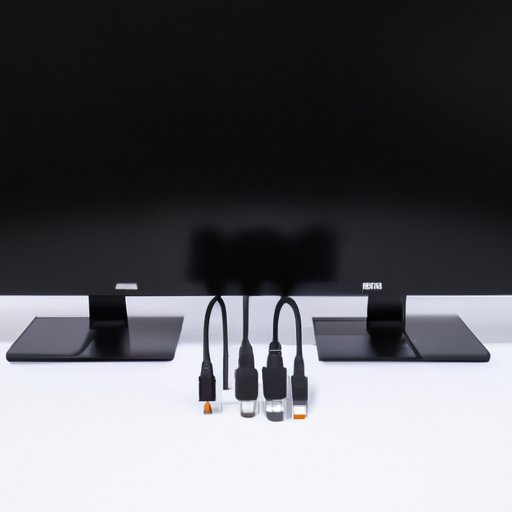
Introduction
In today’s fast-paced world, we all need to stay productive and get our work done quickly and efficiently. However, using a laptop screen alone can sometimes feel restrictive, and it can be challenging to multitask. That’s where using two or more monitors comes in handy. In this article, we will explore seven different ways to connect two monitors to your laptop.
Option 1: HDMI splitter
An HDMI splitter is a device that allows you to split a single HDMI signal into two different output streams. To connect two monitors using an HDMI splitter, you will need an HDMI splitter, two HDMI cables, and your laptop.
1. Connect one end of the HDMI cable to the HDMI output port on your laptop.
2. Connect the other end of the HDMI cable to the input port on the HDMI splitter.
3. Connect the two HDMI cables from the HDMI splitter to the HDMI input ports on your monitors.
4. Turn on your laptop and monitor, and you should now be able to see your desktop extended across both screens.
Option 2: USB-C port
Most modern laptops come with a USB-C port that can be used to connect two monitors. However, not all USB-C ports have this capability, so be sure to check your laptop’s specifications beforehand.
1. Purchase a USB-C to HDMI or USB-C to DisplayPort adapter, depending on the video inputs supported by your monitor(s).
2. Connect the adapter to the USB-C port on your laptop.
3. Connect the HDMI or DisplayPort cable from the adapter to the input port on your monitor.
4. Repeat the process for the second monitor.
5. Adjust your display settings on your laptop to extend the desktop across both screens.
Option 3: Docking station
A docking station is a device that connects to your laptop and provides multiple ports, including HDMI and DisplayPort, which you can use to connect your monitors.
1. Purchase a docking station with dual-monitor support.
2. Connect the docking station to your laptop.
3. Connect the HDMI or DisplayPort cables from the docking station to your monitors.
4. Adjust your display settings on your laptop to extend the desktop across both screens.
Some good docking stations to consider include the Plugable UD-6950H, the Dell D6000 Docking Station, and the Kensington SD7000 Surface Pro Docking Station.
Option 4: VGA and HDMI cables
If your laptop is a bit older, it may not have HDMI or DisplayPort outputs. In that case, you can use VGA and HDMI cables to connect two monitors.
1. Connect the VGA cable from your laptop’s VGA output port to the VGA input port on the first monitor.
2. Connect the HDMI cable from your laptop’s HDMI output port to the HDMI input on the second monitor.
3. Adjust your display settings on your laptop to extend the desktop across both screens.
Option 5: Configuring laptop settings
If you’ve connected your monitors, but they’re not displaying the desktop in the way you want, you might need to adjust your laptop’s display settings.
1. Right-click on your desktop and select “Display settings.”
2. Click “Multiple displays,” then choose from options like “Duplicate desktop,” “Extend desktop,” or “Second screen only.”
3. Arrange your monitors by dragging and dropping them to the desired position.
4. Adjust resolution settings to optimize display quality.
Option 6: Wireless technology
If you prefer a more streamlined approach to setting up multiple displays, you might want to use wireless technology.
1. Use Miracast or Chromecast to wirelessly connect to your monitors.
2. Configure display options through laptops wireless display settings.
While going wireless provides flexibility, keep in mind that some applications may not work as smoothly as with physical display connections.
Option 7: Troubleshooting common issues
Connecting two monitors to your laptop can sometimes come with troubleshooting issues. Here are some common problems and possible solutions:
1. “No signal” message: Ensure all wires are properly inserted and monitor properly selected to the display input source.
2. Poor resolution: Check display settings and ensure all three devices (laptop and two monitors) support the desired resolution.
3. Mirroring issues: Make sure your computer and all three monitors support mirroring.
Conclusion
By now, it should be clear that there are several ways to connect two monitors to your laptop. Depending on the options available on your laptop and which type of monitors you have, some ways could work better than others. We encourage you to experiment with different methods to find what works best for you. Don’t let a smaller display limit your productivity, and take advantage of the full potential that multi-monitor setups offer.





